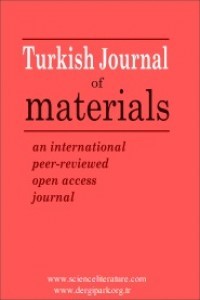
Turkish Journal of Materials
Yazarlar: Salih Yılmaz, Ahmet Ünverdi, Murat Tomakin, Melek Altay, İsmail Polat, Emin Bacaksız
Konular:-
Anahtar Kelimeler:-
Özet: This paper searches for varying Cr-doping on both physical, optical properties of CdS thin films and their photovoltaic applications. CdS:Cr thin films with Cr atoms from 0 to 8% are produced by chemical bath deposition. X-ray diffraction conclusion shows that all samples grow in cubic structure and Cr-doping leads to formation of nanocrystalline CdS structure. Scanning electron microscopy data demonstrates that a reduction in grain size is obtained by Cr-doping. P3HT layer is almost uniformly coated on N3-modified CdS or CdS:Cr surfaces. 2% and 8% Cr-doped CdS thin films exhibit better transparency than that of CdS sample in the visible region. Band gap values increase from 2.98 eV to 3.36 eV when Cr-doping concentration alters from 0% to 4%, which could be probably due to the quantum confinement effect. Absorbance of CdS-based device decreases after Cr-doping. Photoluminescence curves illustrate that peak intensity increases upon Cr-doping that is ascribed to radiative recombination induced by Cr atoms. Photoluminescence data displays that Cr-doped CdS-based devices have higher peak intensity than that of CdS. It is obtained from photovoltaic measurements that CdS-based hybrid solar cell demonstrates a power conversion efficiency of 0.296%.